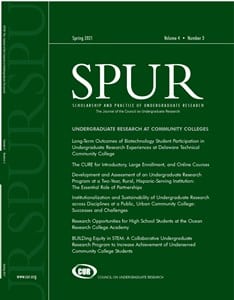SPUR (2021) 4 (3): https://doi.org/10.18833/spur/4/3/3
More Articles in this Issue
- Vignette‐ Beatriz Villar-Fernandez, Danielle N. Ringhoff, John K. Leiser, and Jacalyn D. Speicher
SPUR (2021) 4 (3): https://doi.org/10.18833/spur/4/3/7 - Vignette‐ Todd Pagano, Morgan Bida, Annemarie D. Ross, and Susan Smith Pagano
SPUR (2021) 4 (3): https://doi.org/10.18833/spur/4/3/5 - Vignette‐ Kaatje J. van der Hoeven Kraft and Karen M. Kortz
SPUR (2021) 4 (3): https://doi.org/10.18833/spur/4/3/2 - Practice‐ Joan Petersen, Maria Mercedes Franco, Sharon Lall-Ramnarine, and Shiang-Kwei Wang
SPUR (2021) 4 (3): https://doi.org/10.18833/spur/4/3/16 Abstract:Undergraduate research (UR) is an integral part of the culture at Queensborough Community College, CUNY (QCC), an urban community college with a diverse student population. Since 2015, more than 400 students participate in undergraduate research experiences each year, working with more than 40 faculty mentors from several academic departments. Although a large proportion of this research occurs within STEM fields, the social sciences, nursing, business, arts, and the humanities are also represented and have increased research activity each year. This article describes the various approaches of QCC to institutionalize, promote, and support UR; approaches to handling the challenging aspects of sustaining UR at a community college; and recent initiatives to expand UR across disciplines.
- Practice‐ Ardi Kveven
SPUR (2021) 4 (3): https://doi.org/10.18833/spur/4/3/13 Abstract:Providing opportunities for students to engage in undergraduate research is well supported as a high-impact educational practice. Shifting research experience earlier in the undergraduate career provides opportunities for more students to yield gains (both personal and professional) earlier in their career. At the Ocean Research College Academy (ORCA), undergraduate research starts when students are in their third year of high school. As part of a dual credit/enrollment program in Washington state, students earn an associate of arts and science degree when they graduate from high school. With 17 years of data and more than 500 graduates who have compelling matriculation rates and baccalaureate degree attainment, ORCA provides a model for program and course-based undergraduate research replicable by others.
- Practice‐ Jared Ashcroft, Veronica Jaramillo, Jillian Blatti, Shu-Sha Angie Guan, Amber Bui, Veronica Villasenor, Alina Adamian, Gabriela Chavira, Carrie Saetermoe, Eileen le, Bryant Horowitz, Brissa Palacios, Pamela Byrd Williams, Erika Brockman, and Jennifer Moses
SPUR (2021) 4 (3): https://doi.org/10.18833/spur/4/3/11 Abstract:Undergraduate research programs at community colleges maximize their impact through partnerships with baccalaureate-granting institutions, which provide much needed access to subject matter experts, research labs, and funding to underserved students. The program Building Infrastructure Leading to Diversity: Promoting Opportunities for Diversity in Education and Research (BUILD PODER) partners baccalaureate-granting California State University, Northridge with community college faculty and students to facilitate undergraduate research and development at community colleges. Eighty-one community college students and 41 community college faculty mentors have participated in BUILD PODER, performing research in STEM and biomedical disciplines. The authors document student, faculty, and institutional outcomes as well as share best practices in forming community college–university partnerships. Future directions also are offered in the development and implementation of transdisciplinary, multiinstitutional community college collaborations.


